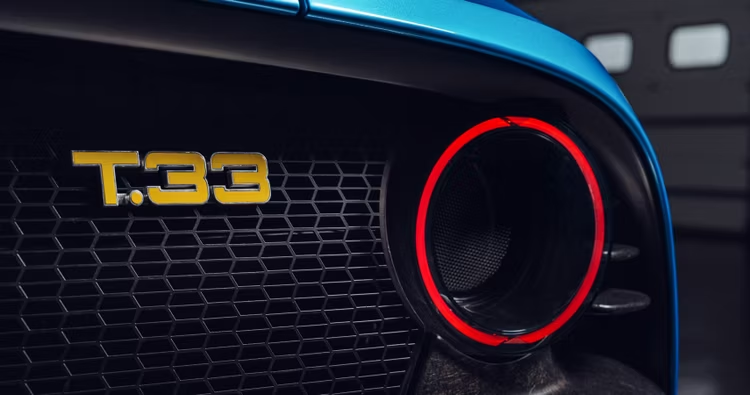How The GMA T.33 Spider Achieves Aerodynamic Greatness Without Splitters And Spoilers
- Mainly Motoring
- Jul 31, 2023
- 4 min read
Alongside its howling V12 engine, Gordon Murray’s all-new T.33 Spider perfects aerodynamics without ostentatious spoilers, and it’s a thing of beauty.
BY SAM MAIN
VIA HOTCARS
PUBLISHED APR 11, 2023

When Gordon Murray first introduced the Gordon Murray Automotive (GMA) T.50, hailing it as the modern successor to his masterfully designed McLaren F1, many questioned whether such a feat could have been pulled off. Years later, and with the first T.50 now rolling off the production line, it appears that vision has become a success. So much so that GMA was quick to unveil another new model in its line-up; their first V12 Spider supercar, that being the all-new GMA T.33 Spider.
From the outset, it is clear the T.33 Spider is an entirely different animal compared to the GMA genesis of the T.50. Developed in parallel with the standard T.33 hardtop, the Spider presented new challenges for the Gordon Murray group. It had to be engineered to maintain exceptional torsional stiffness in the chassis to provide immersive handling and agility. It was also to be a timeless open cockpit design, so it could thrill its occupants on those glorious summer days; roof down, with its Cosworth V12 howling. Thanks to the genius of the Gordon Murray group, that goal has seemingly been achieved.
The T.33 Spider Supercar Has Race Car Aero Without Large Spoilers

A key principle for designer Gordon Murray was for the T.33 Spider to be a timeless vehicle. A Spider that transcended time in terms of looks and beauty and would remain a work of art for years to come. This presented many design opportunities but many challenges for the aerodynamics department. Nevertheless, GMA’s engineers came through and made the T.33 Spider have racing car-like aerodynamics without the usual ducts, skirts, and splitters that are now abused by other car manufacturers.
The GMA T.33 Spider has an innovative and ground-breaking ‘Passive Boundary Layer Control’ system, which was first seen on the standard T.33. This refined system features a ground-effect inlet at the front of the Spider, which channels low-pressure air underneath the floor of the chassis and into the rear diffuser with a boundary layer removal duct. To provide extra downforce in the corners and at high speeds, an active rear spoiler deploys, helping to deliver a low-drag, high-downforce driving experience for the driver.
The New GMA Spider Has A Rigid Race Car Chassis Design

While its aerodynamic properties make it a true derivative of race car engineering, an issue that always presents itself to designers and engineers when taking the roof of a car is stability. The car inherently handles less intuitively and has a weakened chassis strength. However, this is where the T.33 Spider shines brighter than its competition.
The T.33 Spider performance car uses GMA’s ‘iStream Ultralight’ carbon monocoque chassis design technology. This utilizes a carbon fiber composite construction that maintains a rigid body structure and provides both safety, lightness, and handling stiffness. But that’s not all. An integral body design element of the new GMA Spider, the fixed rear roof section, provides rollover protection for the occupants and optimizes stiffness in the corners. The design of the fixed rear roof maintains the ‘twin humps’ from traditional speedsters while also minimizing drag and buffeting when the Spider is an open cockpit.

The benefit of this innovative chassis construction and the T.33 Spider’s aerodynamics is that it has a target dry weight of 2,442 lbs. Only a staggering 39 pounds heavier than the conventional coupe T.33. This is a truly incredible achievement by the Gordon Murray Group. Designing an open-top Spider is always deemed to become heavier, ruining its driving dynamics. But the T.33 Spider defies all odds by having it maintain a true race car experience through simple aerodynamics and chassis design.
GMA’s New T.33 Spider Is A Timeless Performance Car

The T.33 Spider is a truly revolutionary car, an engineering masterpiece that paves way for the future of the performance car. It respects the ethos of the supercar while innovating and pushing the boundaries on what is technically possible. The masterful aerodynamic and chassis design is just one cog in what makes the T.33 Spider a true-performance car.
Cosworth’s incredible 11,100 RPM V12 engine provides a breathtaking engine note that equals a classic Formula 1 car. The overall design of the car is simple and sleek yet functional, which makes it timeless. It even benefits from having one of the lightest gearboxes ever fitted to a production car, yet another truly remarkable feat of engineering genius done by the Gordon Murray Group.

It's safe to say the T.33 Spider will provide all its lucky 100 customers with an unforgettable driving experience. A naturally aspirated 607 hp V12 engine, a manual gearbox, rear-wheel drive, and rudimentary driving controls. Chances are, with emission regulations and the squeezing out of the internal combustion engine, we likely will never see a car like the T.33 Spider again. However, we hope this is not the case.
The T.33 Spider demonstrates the level of design and mechanical innovation that occurs when engineers are left to their own devices. And it's thanks to the genius of the Gordon Murray Automotive Group that a driving machine like the T.33 Spider can exist. It is a supercar that is simple in design yet masterful in its aerodynamics and handling ability. It is a true performance car that, thanks to Murray's decades of experience in the motorsport and supercar industry, has achieved aerodynamic greatness.






Comments